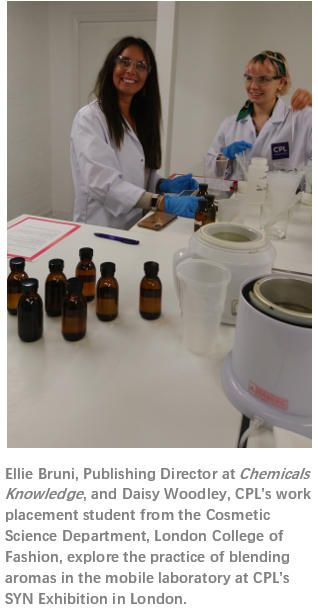Cosmetics & Personal Care
Sensing a difference 20th May 2019
By Sarah Harding, PhD
Can you smell the difference between a natural fragrance and one that is synthetic? It’s harder than you might think! Sarah Hard
Can you smell the difference between a natural fragrance and one that is synthetic? It’s harder than you might think! Sarah Harding visited CPL Aromas’ SYN exhibition in London to see how the company is blending natural and synthetic ingredients to create unique fragrances.
At the end of the 19th century, chemists began synthesizing fragrant molecules such as coumarin and synthetic musks, revolutionizing the industry and giving rise to modern perfumery. However, in the past few years, social and political changes have driven the ‘naturals’ trend, making many manufacturers return to nature for their raw ingredients.
Perceived as being safer, more sustainable and ‘greener’ than synthetic alternatives, natural ingredients continue to be a mega-trend across many industries. However, ‘natural’ doesn’t always mean ‘green’ – the harvesting of rare natural resources can put unprecedented pressures on our environment and in some instances synthetic molecules obtained through green chemistry or white technology (eg. using enzymes and yeast to manufacture synthetics) can represent a more sustainable, reproducible and environmentally-friendly way to formulate a product. ‘Natural’ also doesn’t always mean safe – most of the allergens that have been identified in the fragrance industry are present in natural oils.
Therefore, in the fragrance industry at least, synthetic chemicals are gaining a more positive profile.
But do synthetic fragrances smell ‘quite right’? You might think that it would be easy to smell the difference between a natural fragrance and one that is synthetic. However, this is not always the case, as I found at CPL Aromas’ SYN exhibition in London recently.
Presented with a series of bottles containing ‘natural’ and ‘synthetic’ ingredients, I joined some more experienced experts in the field of fragrances to see if we could sniff out a difference. It really wasn’t as easy as any of us thought. Natural clove extract might be a little more complex than synthetic eugenol, but there was very little detectable difference between bergamot and linalyl acetate, or between jasmine and benzyl acetate.
This would suggest that there is no olfactory sacrifice to be made when using synthetics to formulate a fragrance. This is good news when you consider that synthetic ingredients are also frequently less expensive. They can also be manufactured under strictly controlled conditions to ensure that they offer consistency, and contain no trace allergens or photosensitizers if they’re not supposed to. They may also, in some circumstances, be a more sustainable and reliable option than natural ingredients.
The multitude of natural and synthetic ingredients that can be extracted or created offer perfumers a vast palette of raw materials with which they can create the right fragrance. At CPL Aromas’ SYN exhibition, the company demonstrated their perfumers’ expertise in interplaying synthetics with naturals to bring new dimensions to their fragrances, refining the rawness of naturals, and adding texture or improving tenacity.
For example, the company’s Aromafusion range, which comprises molecularly distilled naturals with synthetics in exclusive combinations, offers a Mojito Fusion with a fresh lime fragrance that lacks the pine notes that can often interfere with lime. Its Cedar Fusion has been ‘lifted’ with synthetic woody materials to avoid the flatness often associated with natural cedar wood. The approach can also be used to circumvent very high-cost natural ingredients, such as orris root, which has a floral, sweet aroma that has been used in perfumes for many years. However, it also ranks among the most expensive natural fragrance ingredients, so CPL’s Cediris Fusion offers a more reasonably priced alternative with a comparable fragrance.

These Fusions feed into a range of fragrance concepts dreamt up by the expert perfumers at CPL. One of my own favourites was a fragrance called Ocean Floor, which includes dihydromycenol (DHM), Ambroxan (a musky amber-like synthetic compound created as a replacement for natural ambergris) and Hedione HC (methyl 3-oxo-2-pentylcyclopentaneacetate; smells similar to jasmine) to offer a slightly citric impression of a fresh marine world.
Another favourite was a fragrance named Salt Plain. Angela Stavrevska, UK Creative Director and Perfumer for CPL Aromas, explained, “Salt has been very fashionable lately in fine fragrances, although salt doesn’t have a smell, so salt is represented here by a fragrance that is dry and powdery with a mineral note.” This is done with a mixture of Cashmeran (musk indanone, 6,7-dihydro-1,1,2,3,3-pentamethyl-4(5H)-indanone or DPMI), Coumarin (C9H6O2, a vanilla odour) and Amber Xtreme (heptamethyl decahydroindenofuran, a powerful amber musk).
The collection of fragrances on display was emotive and compelling. This was a clear demonstration of how fast-moving the fragrance industry is right now. The technology behind the creation of these ingredients, and their blending into unique fragrances, is at the forefront of change, representing the culmination of dedicated research and development that has broken new ground in re-inventing and enhancing fragrance formulations.
*Hedione, Cashmeran, Ambroxan and Amber Xtreme are registered trademarks.
Author:
Sarah Harding worked as a medical writer and consultant in the pharmaceutical industry for 15 years, for the last 10 years of which she owned and ran her own medical communications agency that provided a range of services to blue-chip Pharma companies. In 2016, she began a new career in publishing as Editor of Speciality Chemicals Magazine, and in 2019 we were honoured to welcome her as Editorial Director at Chemicals Knowledge.
E: Sarah.Harding@ckhglobal.org



